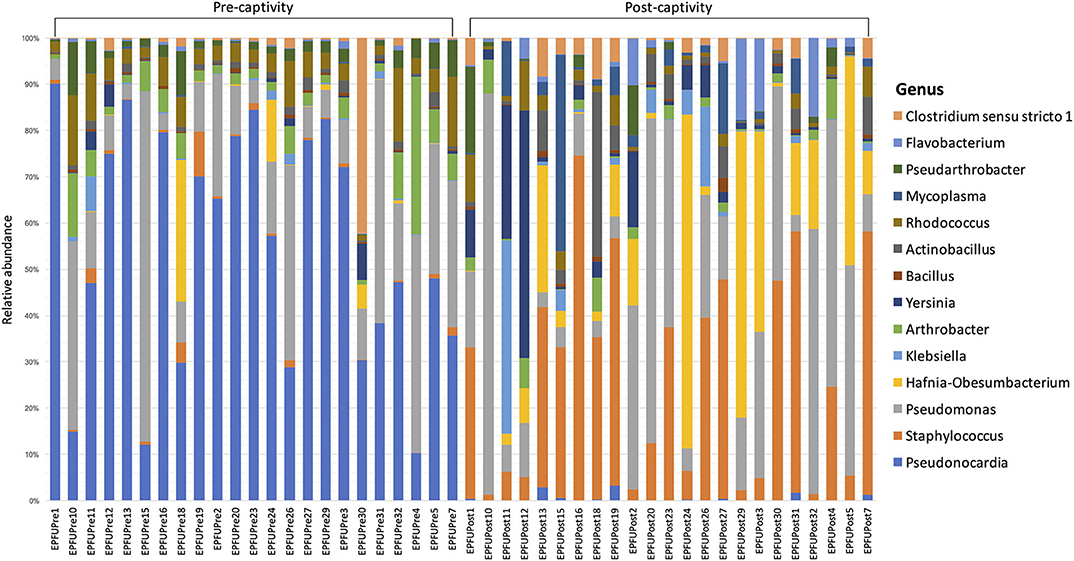
94% of researchers rate our articles as excellent or good
Learn more about the work of our research integrity team to safeguard the quality of each article we publish.
Find out more
CORRECTION article
Front. Microbiol. , 26 October 2020
Sec. Microbial Symbioses
Volume 11 - 2020 | https://doi.org/10.3389/fmicb.2020.588889
This article is a correction to:
Antifungal Potential of the Skin Microbiota of Hibernating Big Brown Bats (Eptesicus fuscus) Infected With the Causal Agent of White-Nose Syndrome
A Corrigendum on
Antifungal Potential of the Skin Microbiota of Hibernating Big Brown Bats (Eptesicus fuscus) Infected With the Causal Agent of White-Nose Syndrome
by Lemieux-Labonté, V., Dorville, N. A. S.-Y., Willis, C. K. R., and Lapointe, F.-J. (2020). Front. Microbiol. 11:1776. doi: 10.3389/fmicb.2020.01776
In the original article, there was a mistake in Figure 3 “Relative abundance of different genera in the microbiota on bat skin from before (pre-captivity) and after (post-captivity) experiment. Analysis was performed on unrarefied ASVs table of taxa with relative abundance higher or equal to 0.1%” as published. The wrong figure version was uploaded and the pre-captivity and post-captivity labels were inverted. The corrected Figure 3 appears below.

Figure 3. Relative abundance of different genera in the microbiota on bat skin from before (pre-captivity) and after (post-captivity) experiment. Analysis was performed on unrarefied ASVs table of taxa with relative abundance higher or equal to 0.1%.
The authors apologize for this error and state that this does not change the scientific conclusions of the article in any way. The original article has been updated.
Keywords: fungal infection, microbiota, resistance, big brown bat, 16S rRNA gene
Citation: Lemieux-Labonté V, Dorville NAS-Y, Willis CKR and Lapointe F-J (2020) Corrigendum: Antifungal Potential of the Skin Microbiota of Hibernating Big Brown Bats (Eptesicus fuscus) Infected With the Causal Agent of White-Nose Syndrome. Front. Microbiol. 11:588889. doi: 10.3389/fmicb.2020.588889
Received: 29 July 2020; Accepted: 08 September 2020;
Published: 26 October 2020.
Edited and reviewed by: Eria Alaide Rebollar, National Autonomous University of Mexico, Mexico
Copyright © 2020 Lemieux-Labonté, Dorville, Willis and Lapointe. This is an open-access article distributed under the terms of the Creative Commons Attribution License (CC BY). The use, distribution or reproduction in other forums is permitted, provided the original author(s) and the copyright owner(s) are credited and that the original publication in this journal is cited, in accordance with accepted academic practice. No use, distribution or reproduction is permitted which does not comply with these terms.
*Correspondence: Virginie Lemieux-Labonté, dmlyZ2luaWUubGVtaWV1eC1sYWJvbnRlQHVtb250cmVhbC5jYQ==
Disclaimer: All claims expressed in this article are solely those of the authors and do not necessarily represent those of their affiliated organizations, or those of the publisher, the editors and the reviewers. Any product that may be evaluated in this article or claim that may be made by its manufacturer is not guaranteed or endorsed by the publisher.
Research integrity at Frontiers

Learn more about the work of our research integrity team to safeguard the quality of each article we publish.